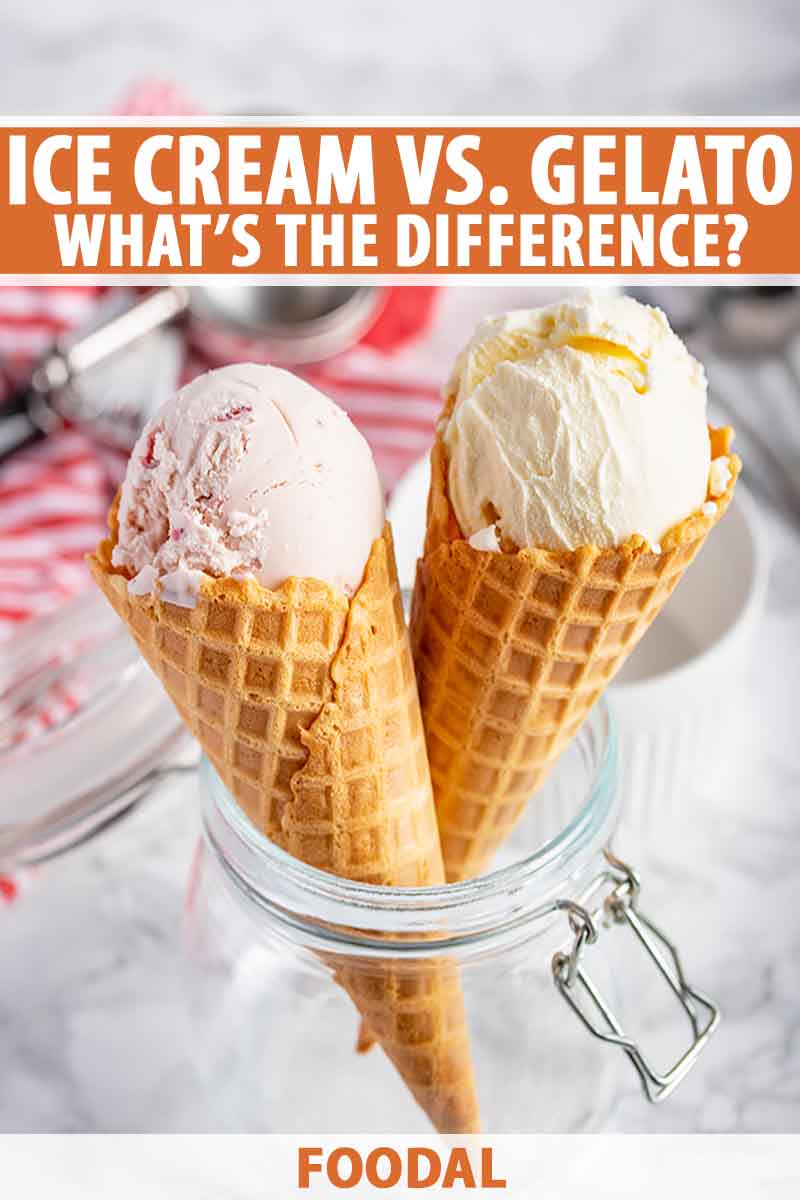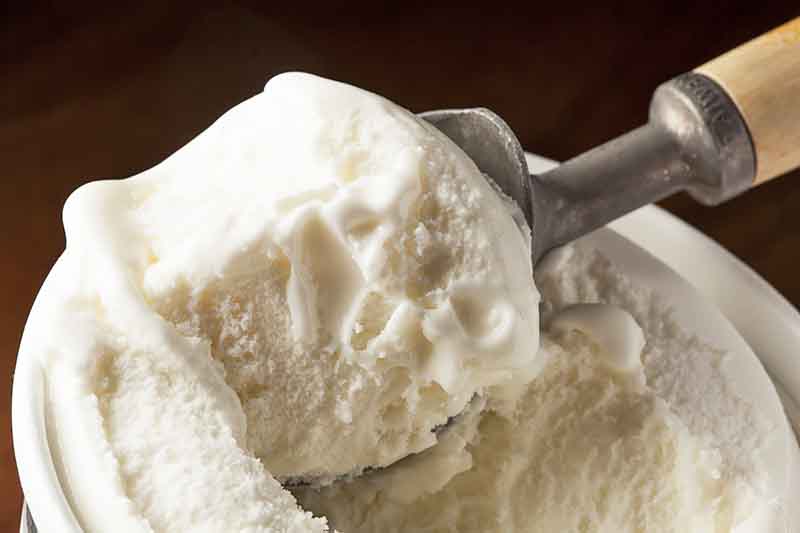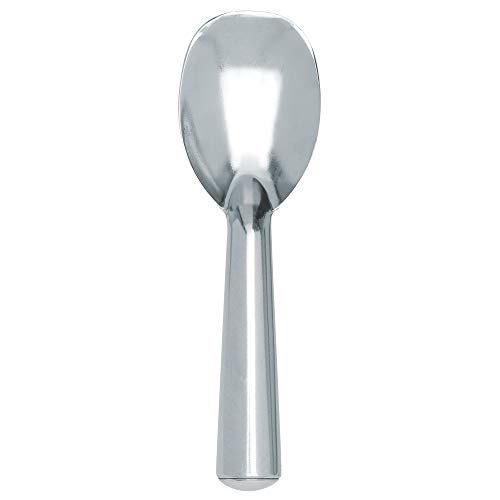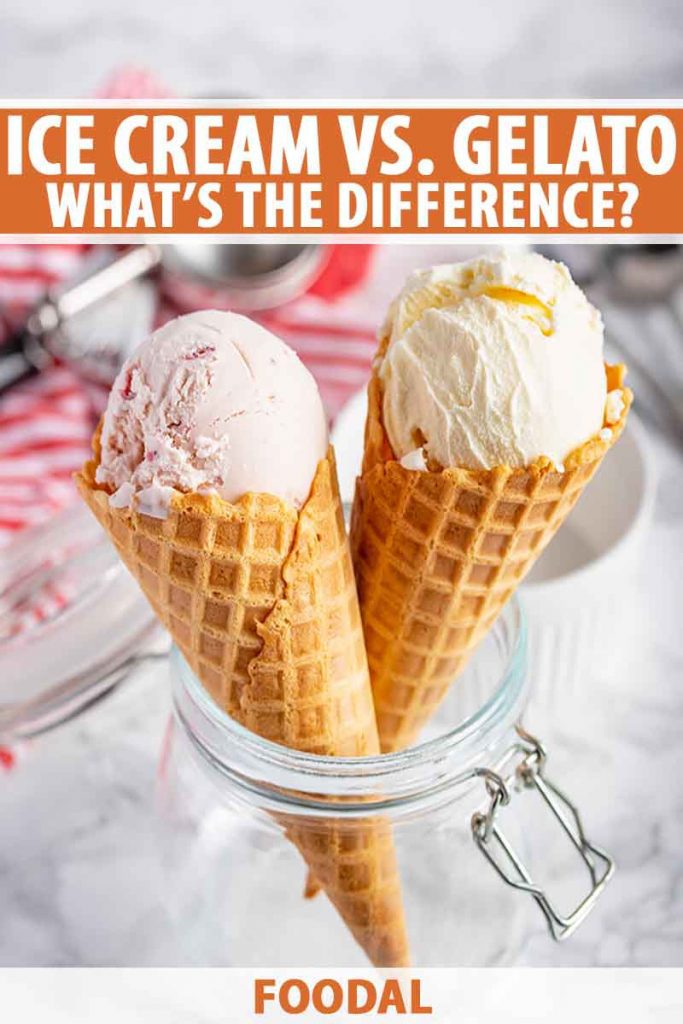We occasionally link to goods offered by vendors to help the reader find relevant products. Some of these may be affiliate based, meaning we earn small commissions (at no additional cost to you) if items are purchased. Here is more about what we do.
When you fling open the freezer door in the frozen sweets section of the grocery store, what kind of dessert are you after?

You’re likely seeking out something scoopable and cold, but there are finer details to take into consideration. And as your eyes dart back and forth between nearly identical containers, do you ever find yourself wondering:
What’s the difference between ice cream and gelato, anyway?
They’re often displayed side by side in a multitude of flavors, each equally as tempting. Or maybe you’re struggling to choose between the local parlor down the street and the gelato place at the mall.
So, what gives?
There are several elements that differentiate the two. Here’s everything we’ll cover up ahead:
What’s the Difference Between Ice Cream and Gelato?
Fat Content and Other Ingredients
First, there’s the almighty fat factor. Ice cream is comprised of more cream than milk, hence the name, whereas gelato has a greater amount of milk, usually whole (full fat).

Gelato is the Italian word for ice cream, though it literally translates to “frozen,” and may sometimes be used to describe other types of frozen desserts as well.
And the generic “ice cream” that we’re comparing it to here is American-style, sometimes referred to as Philadelphia-style or “standard” when it’s made without eggs, or custard when it is. The American-style frozen desserts are celebrated for being heavy on the cream, a characteristic that gives them an abundance of fat.
Worldwide, these are probably the two most popular varieties of this frozen sweet treat, but if you search the globe you’ll find plenty of other examples that use their own unique lists of ingredients and preparation processes, including kulfi, helado, dondurma, sorbetes, and more.
Take a peek at a typical recipe for French or custard-style ice cream and you’ll find cream, milk, and sugar, as well as egg yolks. Adding yolks to a cooked base results in a thick texture and a cooked eggy flavor.
As far as official rules go, according to FDA labeling law, any product sold as ice cream in the US must be constituted of no less than 10% milkfat. Any less than that, and it qualifies as reduced-fat, low-fat, light, or nonfat ice cream, or “ice milk.”
In order to maintain a smooth consistency and keep ice crystals small in commercial versions of these low-fat products, additives like corn syrup and vegetable gums are used.

Gelato, on the other hand (or spoon), typically uses fewer – if any – yolks in addition to the dairy and sweetener. As far as regional variations go, the recipes hailing from northern Italy may rely on egg yolks as a thickening agent, whereas in southern Italy, cornstarch is often used for the same purpose.
As for gelato sold in the US, you may find it with or without egg in the list of ingredients.
On the surface, its composition appears the same as an American style dessert with its comparable base of milk, cream, and sugar. But a closer look at the proportions – keeping in mind that ingredients found in the highest quantity in packaged foods always appear first on the label – show that gelato boasts more milk and less cream, and thus, less fat.
The total fat content in gelato is usually closer to 5 to 7%.
It may not be as rich and smooth as ice cream, but it has that gloriously milky mouthfeel, which some folks believe produces a more intense flavor. This could be the case, since there’s less of that tongue-coating cold fat. But the operative word here is “cold.” We’ll get to temperature in a little bit, so keep reading!

Sugar is also a key ingredient in both of these frozen treats, unless you purchase or prepare a specialty product that doesn’t contain any. Artificial sweeteners may have a different effect on the mix, and other ingredients will need to be used to create a creamy and satisfying blend. But as far as the good ol’ granulated stuff goes, here’s a quick note on its all-important role in the operation:
According to Harold McGee, author of “On Food and Cooking: The Science and Lore of the Kitchen,” once the sugar is dissolved into the mixture, churned, and chilled so it hardens, a lingering fifth of the ice cream’s remaining water doesn’t freeze, leaving a thick fluid behind. This coats the ice crystals and causes them to cling together.
Trapped air cells lighten its structure, and in turn, expand its volume. But more on that next. (You can also find McGee’s book on Amazon).
Ultimately, none of this makes gelato any less delicious than ice cream, just different in terms of the overall ingredient ratios, and amount of fat.
Air
Onto the tantalizing topic of air. Though air is invisible to the naked eye (I mean, just look around you…), it makes all the difference in this particular culinary application.

Gelato contains less air, which results in a denser dessert.
The American-style frozen dessert seems to follow the stereotypically American model of work hard, play hard. The ice cream maker wastes no time in churning the custard base. It’s whipped at a swift pace with a rotating dasher, which incorporates air into the mix, exposes the base to cold, helps in creating a smooth texture, and increases its volume.
Ever wondered why premium cartons actually have a higher price tag (other than the fact that they contain a higher quantity of more expensive ingredients like cream and egg yolks)? The cheaper brands have more air whipped into them, and thus, less flavor – and a thinner texture that may melt more quickly when you turn your back on them to search for sprinkles.

Gelato is churned at a much slower, more gentle speed, as the dasher used often moves up and down to break up the ice crystals and thoroughly chill the base, as opposed to rotating in rapid circles. This results in a far denser final product with little to no air mixed in.
If the idea that you’re paying a few dollars less only to purchase more invisible air doesn’t convince you to buck up and buy a superior product the next time you’re shopping, I don’t know what will.
You can also recognize the higher quality dessert by weighing one container against another, or by flipping over the carton and eyeing the weight per serving. The good stuff will be heavier.
Temperature
Finally, let’s talk temperature.

Both of these styles are emulsions of two substances that don’t normally mix readily: fat and water.
After being churned (when the ice crystals are at their smallest), the mixtures go into the hardening phase to freeze more thoroughly. If hardened at too high of a temperature – particularly ice cream, with its elevated fat content – they will separate readily into melty dessert soup.
Ice cream is at its best when it’s stored at or below 0°F, while gelato requires a temperature that’s a touch higher to be at its peak. If the small ice crystals begin to melt and then refreeze (which happens with frequent door opening and closing, or every time you sit on the couch with Ben & Jerry and then return them to the freezer), the dessert hardens and big lumps can form.
In a sub-zero freezer that isn’t opened repeatedly, the smooth texture is preserved.
If frozen too cold, gelato’s density factor doesn’t work in its favor, as it will become rock solid and much harder to scoop. But when stored and served properly (at around 15°F), its plush, elastic consistency comes through.

As far as serving goes, about 10°F is the sweet spot for ice cream, which can be achieved by letting it sit on the counter at room temperature for around 10 to 15 minutes, or in the fridge for 20 to 30 minutes. Both methods result in a softer texture and more enjoyable dessert experience overall, since totally frozen foods at 0°F tend to numb our taste buds.
Though most grocery store freezers as well as home freezers all maintain the same temperature, around 0°F or below, you can expect these requirements to be adhered to attentively at your local gelateria – an added benefit to purchasing your gelato in single servings at a specialty store.
Serving Suggestions
Speaking of those servings, are you ready for a big bowlful?

Ice cream and gelato are as creamy and dreamy as desserts come, and we’ve almost covered the differences from start to finish.
Now that you know the process of how each made their way into their cute little containers, it’s time to bring them to the bowls. Or cones! But don’t use that deeply rounded scoop to collect your gelato.
A scoop is best used for shaping American-style ice cream into firm, rounded balls, while gelato is typically served with a flat spatula-like spade. This authentic Italian tool can also neatly slide into thick, hard ice cream, but most importantly, it plays a part in manipulating the dessert’s texture just before serving.
There’s an artistry to it, and using a spade is not just an arbitrary tradition. It’s specifically designed for working the gelato and softening it to the preferred consistency for the best flavor and texture.

HIC Harold Import Co. Frozen Dessert Spade, available on Amazon
I like the frozen dessert spade from HIC Harold Import Co. It’s filled with anti-freeze fluid, to keep frozen desserts from sticking, and it’s available on Amazon. They also offer a classic stainless steel spade with a plastic BPA-free handle. You’ll find it on Amazon as well.
One Scoop or Two?
We could sit here all day and discuss the chemistry of these concoctions in even more detail, but instead, let’s just grab a spoon and partner up with a pint.

Are you with me?
Though the differences are subtle, they all affect how the treats land on your tongue. And in the end, isn’t the goal to choose what will make your mouth happiest?
No matter how you choose to dig into either one, everybody comes out on top.
Are you a fan of modest ingredient combos like cookies and cream, or do you get down with elaborate and more unique mashups like sweet corn and peach? Share your favorite flavors in the comments below!
And keep the frozen dessert party going by practicing your scratch-made skills with these scoop-worthy recipes and kitchen gear:
- Pumpkin Cinnamon Ice Cream
- Pomegranate Orange No-Churn Ice Cream
- A Review of the DeLonghi GM6000 Gelato Maker
© Ask the Experts, LLC. ALL RIGHTS RESERVED. See our TOS for more details. Uncredited photos: Shutterstock. With additional writing and editing by Allison Sidhu.
About Fanny Slater
Fanny Slater is a home-taught food enthusiast based in Wilmington, North Carolina who won the “Rachael Ray Show” Great American Cookbook Competition in 2014, and published her cookbook “Orange, Lavender & Figs” in 2016. Fanny is a food and beverage writer, recipe developer, and social media influencer. She was a co-host on the Food Network series “Kitchen Sink,” was featured on Cooking Channel’s longtime popular series “The Best Thing I Ever Ate,” and continues to appear regularly on the “Rachael Ray Show.”




